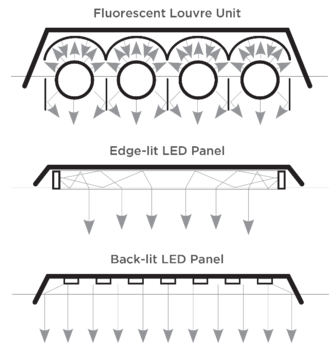The LED panel is the fixture that is making the largest contribution to energy savings in the corporate sector. The switch from fluorescent louvred ceiling grid units to LED is well underway, but which format of panel should we choose?
LED panels have been available in two distinct designs: side/edge-lit and backlit. Let’s explore the advantages of each design and consider which is best suited for you.
Efficacy
Short-lived tubes and ballasts and, of course, the dreaded flickering were reasons why fluorescents were disliked by office workers and managers alike. Initial versions of the LED replacements offered only a marginal benefit in terms of luminous efficacy – 64 lm/W were swapped with 78 lm/W when the first edge-lit LED units appeared. Over time, each new generation of LED panels has delivered improved ratios of power to light.

Edge-lit versus backlit
In edge-lit models the LED chips are arranged on the inner edge of the luminaire. The light is then bounced downwards through a diffuser. Edge-lit was the most popular format in the LED panel category during the introductory stage of the LED lighting market. However, there has been a parting of the ways between models in terms of efficiency.
Backlighting has proved the natural benefit of projecting light through less material. Edge-lit retains a share of the market where unit costs are a higher priority than running costs, and where there is an aesthetic preference. However, the real saving is in the lower operational costs delivered by backlit panels.
The bottom line
Corporate cost savings are a hard-nosed decision. With every breakthrough in luminous efficacy in terms of power to light, the payback time on installations shortens, while the unit cost of LED panels continues to fall.
Choosing to switch from fluorescent lighting schemes to LED panels for an office has become a no-brainer for both commercial business and public organisations. Increasingly, the need to replace less efficient legacy LED panels with newer, more efficient models will be on the schedule too
Prev:no.